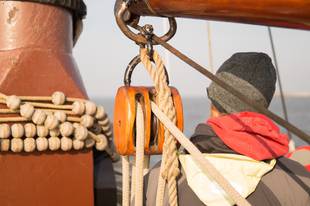
WORK
The word work is a common term in our everyday living. When people say they go to work, or say they have lots of work to do. But in science, the term work has a special meaning. Work is done only when a force moves an object like when you push, lift or throw an object. Work is an amount of force acting through a distance. For work to be done, an object has to be moved from one place to another. In formula:
W = F x d
where W – is work
F – done
d – is distance
To be able to perform work, a force has to be applied and the object must move through a certain distance. In the above formula, force is expressed in Newton while distance is in meters. The unit of work is therefore N-m. In the metric system, a Newton-meter is called joule.
POWER
Power, like work, has different meanings to common people. In science, power tells us how fast something is happening. Power is the rate of which work is being done. In formula,
P = work
time
where W = F x d
The formula for power can also be written as
P = F x d
time
The unit of power is joules per seconds or watts. 1 watt is equal to 1 joule per second.
Machines
What is machine? It is any device that makes work easier by changing force and distance or by changing the direction of a force. Machines are not limited to the complicated devices you may be thinking of. There is what we call simple machines. It is any device that helps us perform common tasks. There are so many common activities that would be difficult to perform without devices being normally used. Imagine cutting papers without scissors, cutting meat without knives. Machine is not always heavy equipment like car engines or factory equipment. But rather we have these machines which are simple and part of our everyday living. There are six types of simple machines: inclined plane, wedge, screw, lever, pulley and wheel and axle.
Incline Plane
An inclined plane is simply a flat slanted surface used to raise an object. It is a simple machine with no moving parts but it multiplies force. How? Suppose you had to move a heavy box from one place to another. Instead of lifting the object, you could reduce the amount of force you need to carry the box by just allowing it to slide along the plane.
What are other examples of inclined plane? Wedge and screw are examples of inclined plane. A wedge is usually a piece of wood or metal that is thinner at one end. A knife and an ax are examples of wedge.
The importance of the wedge is seen in many devices. The lock and its key is a device that depends on the principle of the wedge. The edges of the key are a series of wedge which go up and down in a certain pattern. The wedges lift up a number of pins of different lengths inside the lock. When all of the pins are lifted to the proper height, which is accomplished by the shape of the key, the lock opens.
How about the screw? It is another device that makes use of the idea of an inclined plane. The screw is in fact an inclined plane wrapped around the central bar to form a spiral. A screw multiplies an effort force by acting through a long distance.
Lever
A lever is a rigid bar that is free to pivot or move about a fixed point. This fixed point is called a fulcrum. There are so many examples of a lever and one of the most common is the seasaw. Though it is an essential attraction of any playground it is a simple machine. One person may be able to lift a large rock with a lever.
There are three (3) kinds of lever: a first class, where the fulcrum is at the center. Examples of this include the seesaw and the crowbar. A second class lever where the fulcrum is at one end is the wheelbarrow. The wheel acts as the fulcrum. The handle where the barrow is lifted is the effort force. A third class lever is one wherein the fulcrum is at the end of the rod is being pulled back. This type of lever reduces the effort force but multiples the distance through which the output force moves. Examples of third class levers are surf-casting rod, shovels, hammers, tweezers and baseball bats.
Pulley
A pulley is a rope, belt or chain wrapped around a grooved wheel. It can function in two ways. It can change the direction of a force or the amount of force. Normally, a pulley is used in lifting heavy objects. It is usually seen on construction sites where large, heavy materials are being lifted. There are two types of pulley: a fixed pulley and a movable pulley. A fixed pulley is one that is attached to a structure. It does not multiply an effort force but it only changes the direction of the effort force. When movable pulleys are used, amount of force can be multiplied. A movable pulley moves with the resistance force but notice that it does not change the direction of force.
A greater mechanical advantage can be obtained by combining fixed and movable pulleys into a pulley system. The more pulley being used, more sections of rope are attached to the system. Each additional rope helps support the object. As an effect, less force is required. This increases mechanical advantage.
Wheel and Axle
A wheel and axle is a simple machine made up of two circular objects of different sizes. The wheel is the larger object that turns about the smaller object called axle. The mechanical advantage of this machine depends on the radius of the wheel. Bicycles, ferris wheel, gears, wrenches, door knobs and steering wheels are all examples of wheel and axle.
Most of the machines that we see and use every day are compound machines. Compound machines is a combination of two or more simple machines. Common examples of compound machines include cars and automobiles, sewing machine, blender, washing machine, VCD and the like.


















